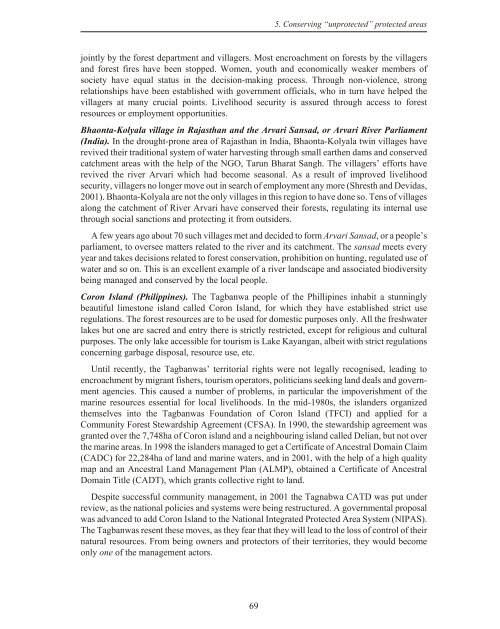The Protected Landscape Approach - Centre for Mediterranean ...
The Protected Landscape Approach - Centre for Mediterranean ...
The Protected Landscape Approach - Centre for Mediterranean ...
You also want an ePaper? Increase the reach of your titles
YUMPU automatically turns print PDFs into web optimized ePapers that Google loves.
5. Conserving “unprotected” protected areas<br />
jointly by the <strong>for</strong>est department and villagers. Most encroachment on <strong>for</strong>ests by the villagers<br />
and <strong>for</strong>est fires have been stopped. Women, youth and economically weaker members of<br />
society have equal status in the decision-making process. Through non-violence, strong<br />
relationships have been established with government officials, who in turn have helped the<br />
villagers at many crucial points. Livelihood security is assured through access to <strong>for</strong>est<br />
resources or employment opportunities.<br />
Bhaonta-Kolyala village in Rajasthan and the Arvari Sansad, or Arvari River Parliament<br />
(India). In the drought-prone area of Rajasthan in India, Bhaonta-Kolyala twin villages have<br />
revived their traditional system of water harvesting through small earthen dams and conserved<br />
catchment areas with the help of the NGO, Tarun Bharat Sangh. <strong>The</strong> villagers’ ef<strong>for</strong>ts have<br />
revived the river Arvari which had become seasonal. As a result of improved livelihood<br />
security, villagers no longer move out in search of employment any more (Shresth and Devidas,<br />
2001). Bhaonta-Kolyala are not the only villages in this region to have done so. Tens of villages<br />
along the catchment of River Arvari have conserved their <strong>for</strong>ests, regulating its internal use<br />
through social sanctions and protecting it from outsiders.<br />
A few years ago about 70 such villages met and decided to <strong>for</strong>m Arvari Sansad, or a people’s<br />
parliament, to oversee matters related to the river and its catchment. <strong>The</strong> sansad meets every<br />
year and takes decisions related to <strong>for</strong>est conservation, prohibition on hunting, regulated use of<br />
water and so on. This is an excellent example of a river landscape and associated biodiversity<br />
being managed and conserved by the local people.<br />
Coron Island (Philippines). <strong>The</strong> Tagbanwa people of the Phillipines inhabit a stunningly<br />
beautiful limestone island called Coron Island, <strong>for</strong> which they have established strict use<br />
regulations. <strong>The</strong> <strong>for</strong>est resources are to be used <strong>for</strong> domestic purposes only. All the freshwater<br />
lakes but one are sacred and entry there is strictly restricted, except <strong>for</strong> religious and cultural<br />
purposes. <strong>The</strong> only lake accessible <strong>for</strong> tourism is Lake Kayangan, albeit with strict regulations<br />
concerning garbage disposal, resource use, etc.<br />
Until recently, the Tagbanwas’ territorial rights were not legally recognised, leading to<br />
encroachment by migrant fishers, tourism operators, politicians seeking land deals and govern -<br />
ment agencies. This caused a number of problems, in particular the impoverishment of the<br />
marine resources essential <strong>for</strong> local livelihoods. In the mid-1980s, the islanders organized<br />
themselves into the Tagbanwas Foundation of Coron Island (TFCI) and applied <strong>for</strong> a<br />
Community Forest Stewardship Agreement (CFSA). In 1990, the stewardship agreement was<br />
granted over the 7,748ha of Coron island and a neighbouring island called Delian, but not over<br />
the marine areas. In 1998 the islanders managed to get a Certificate of Ancestral Domain Claim<br />
(CADC) <strong>for</strong> 22,284ha of land and marine waters, and in 2001, with the help of a high quality<br />
map and an Ancestral Land Management Plan (ALMP), obtained a Certificate of Ancestral<br />
Domain Title (CADT), which grants collective right to land.<br />
Despite successful community management, in 2001 the Tagnabwa CATD was put under<br />
review, as the national policies and systems were being restructured. A governmental proposal<br />
was advanced to add Coron Island to the National Integrated <strong>Protected</strong> Area System (NIPAS).<br />
<strong>The</strong> Tagbanwas resent these moves, as they fear that they will lead to the loss of control of their<br />
natural resources. From being owners and protectors of their territories, they would become<br />
only one of the management actors.<br />
69

















